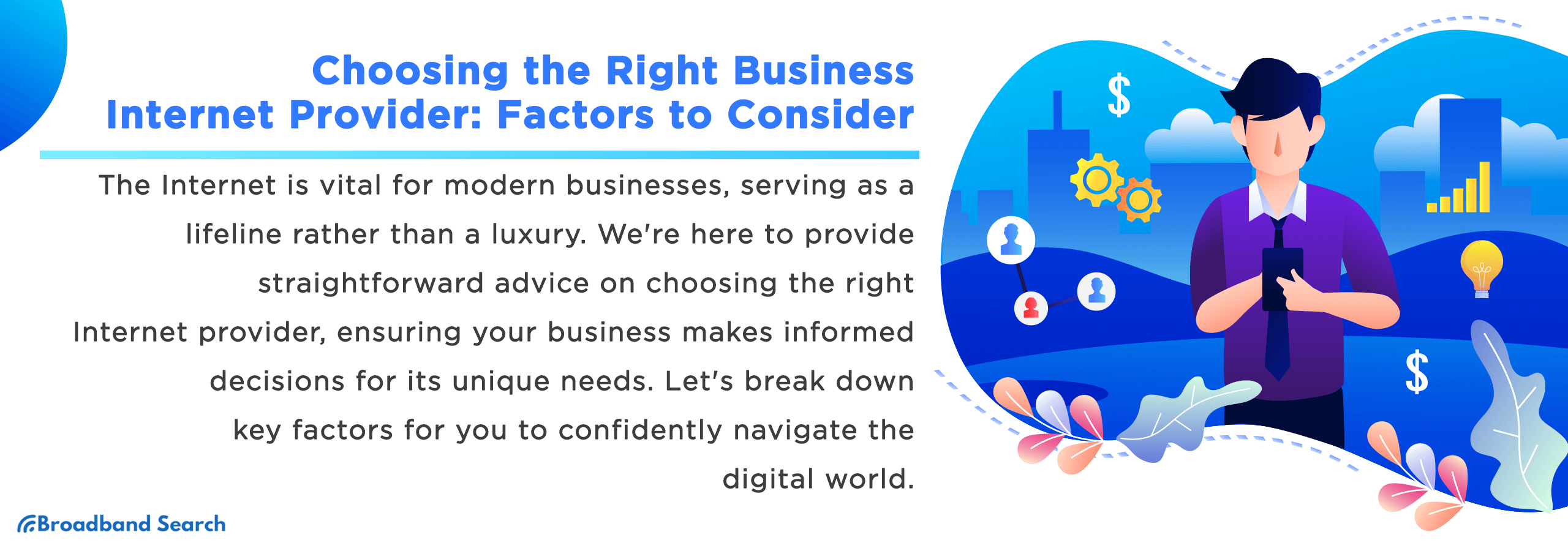The Internet is the backbone of modern business operations. It's not just a luxury; it's a lifeline. Imagine a world where your business couldn't send emails, access cloud data, or even process online transactions. That's the significance of the Internet in today's business landscape.
So, why are we here? Simple. We want to help your business make the best decisions that are tailor-made for your unique internet needs. There is no jargon or mind-boggling tech talk here – just straightforward advice to ensure you choose the right Internet provider. Let's break down the critical factors you need to consider and confidently navigate the digital world.
Understanding Business Internet Needs
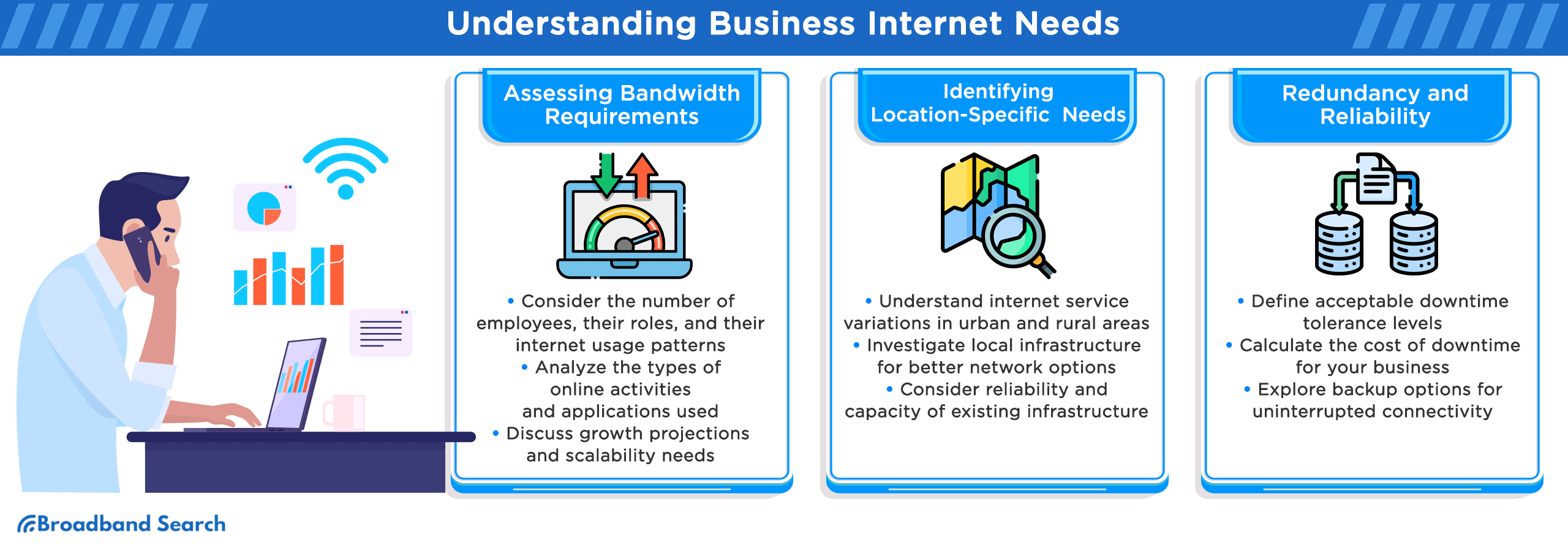
Assessing Bandwidth Requirements
- Consider the number of employees, their roles, and their internet usage patterns: Start by creating a detailed inventory of all employees, noting their job roles, and typical internet usage. For instance, graphic designers, video editors, and developers may require higher bandwidth than administrative staff. Determine peak usage times, as some tasks might be more bandwidth-intensive during specific hours.
- Analyze the types of online activities and applications used: Identify the specific online activities and applications your business relies on. This can include cloud services (e.g., Google Workspace, Dropbox), video conferencing tools (e.g., Zoom, Microsoft Teams), VoIP phone systems, and data transfers. To ensure you have the right information, it's essential to quantify the data usage associated with different applications. Take video conferencing, which can consume 128 Kbps for a low-quality desktop endpoint or up to 20 Mbps for an immersive, multiscreen HD system. Knowing how frequently and how long your team utilizes these tools becomes crucial in this context.
- Discuss growth projections and scalability needs: Take a moment to envision your business's future growth in the coming years. Are there plans to increase your workforce, reach new markets, or introduce more online services? It's crucial to confirm that your chosen internet provider can seamlessly support your scalability requirements while maintaining top-notch performance. This might entail choosing plans with greater bandwidth allowances or adaptable scaling possibilities to accommodate your evolving needs.
Identifying Location-Specific Needs
Understanding location-specific needs is vital, as the availability and quality of internet services can vary greatly. In urban areas, you may have a wide range of internet options, including high-speed fiber connections. However, in rural areas, choices might be limited, and you may need to rely on satellite or wireless connections. Consider the internet landscape in your area.
It would be ideal to investigate the local infrastructure. Urban areas typically have better network infrastructure, while rural areas may have limited access to high-speed options. Take into account the reliability and capacity of the existing infrastructure when choosing a provider.
Redundancy and Reliability
Reliability is absolutely critical when it comes to your business's internet connection. Any downtime can result in lost revenue and productivity, making it essential to ensure your connection remains robust.
To achieve this, start by defining your acceptable downtime tolerance levels. Calculate the actual cost of downtime for your business and determine how long your operations can endure an internet outage without suffering severe consequences (whether that’s seconds or days). This assessment serves as the benchmark for your acceptable downtime tolerance. It's crucial to verify that any potential internet provider's Service Level Agreement (SLA) aligns with this specific tolerance level to ensure they can deliver the reliability your business demands.
Additionally, it's wise to delve into backup options. These solutions are designed to guarantee uninterrupted connectivity, even in the face of unexpected disruptions. Backup options might include failover connections, which automatically switch to a secondary connection if the primary one fails, or automatic switchover to a cellular network during outages.
Exploration of Connection Types
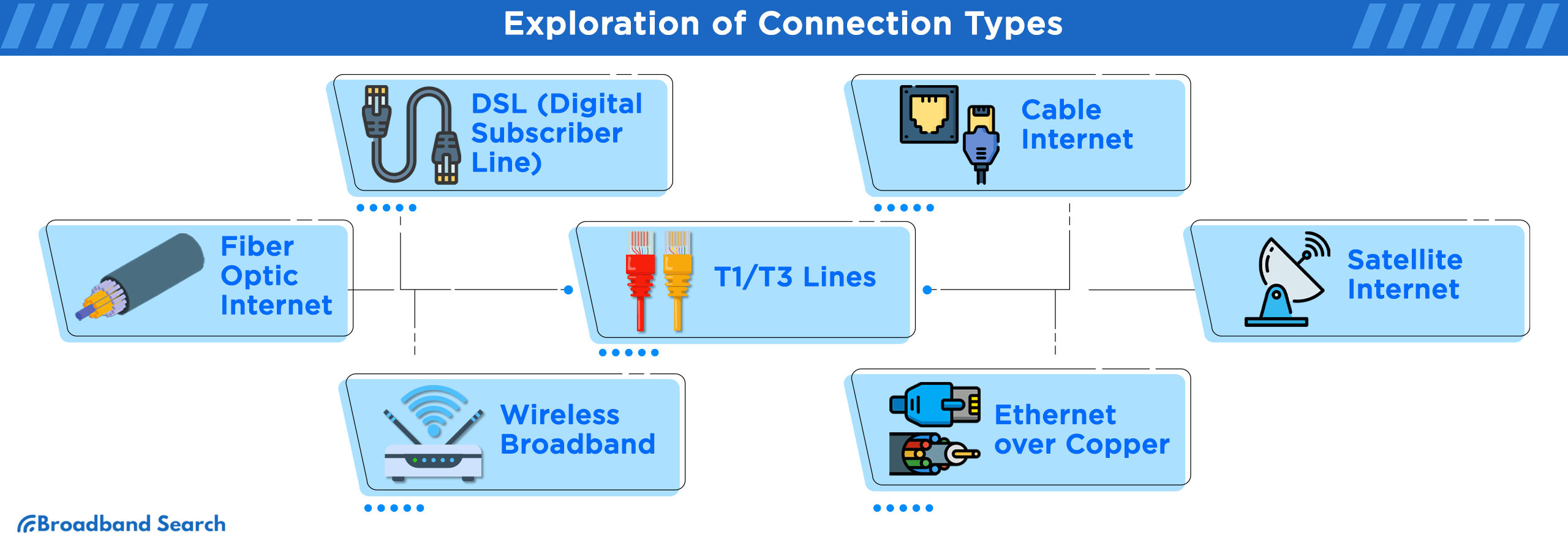
DSL (Digital Subscriber Line)
- Technological Foundation: DSL uses traditional telephone lines to deliver internet access. It operates on different frequencies from telephone data, allowing simultaneous voice and data transmission.
- Benefits: DSL is widely available and cost-effective. It's suitable for small to medium-sized businesses with moderate internet needs.
- Limitations: Speeds can be limited, especially in remote areas, and are distance-dependent from the provider's central office.
- Selection Guidance: Consider DSL for small offices or urban businesses with moderate internet requirements, such as email, web browsing, and light cloud usage. Additionally, it can be a viable choice in areas where alternative options are limited. However, it's important to note that DSL may not consistently meet the needs of larger households or businesses, especially when other alternatives are available.
- Speed Ranges: DSL typically offers latency ranging from 11ms to 40ms. Download speeds commonly range from 1 Mbps to 400 Mbps, with upload speeds from 384 Kbps to 8 Mbps.
- Pricing: DSL prices typically range from a starting price of $39.99 to $55 per month.
Cable Internet
- Technological Foundation: Cable internet relies on the same coaxial cables used for cable television. It offers high-speed internet through a shared network infrastructure.
- Benefits: Cable internet delivers fast download speeds and is suitable for businesses with moderate to high data requirements.
- Limitations: Speeds may fluctuate during peak usage times due to shared bandwidth, and service quality can vary by location.
- Selection Guidance: Opt for cable internet if your business requires higher speeds for tasks like video conferencing, online collaboration, and moderate data transfers.
- Speed Ranges: Cable internet typically features latency ranging from 13ms to 27ms. Download speeds start at around 25 Mbps and can reach up to 1 Gbps, while upload speeds range from 5 Mbps to 50 Mbps.
- Pricing: Cable internet prices vary by provider. Astound, Mediacom, and Xfinity offer broadband starting at approximately $30 per month, while Spectrum starts at around $50 per month with download speeds of up to 300 Mbps.
Fiber Optic Internet
- Technological Foundation: Fiber optic cables use light signals to transmit data, offering incredible speed and reliability.
- Benefits: Fiber optics provide blazing-fast symmetrical upload and download speeds. They are ideal for bandwidth-intensive businesses and those requiring low latency.
- Limitations: Availability may be limited, particularly in rural areas. Installation costs can be high.
- Selection Guidance: Consider fiber optics for bandwidth-hungry businesses, e-commerce sites, or those heavily reliant on cloud services and streaming.
- Speed Ranges: Fiber optic connections boast low latency, typically ranging from 1 to 5 milliseconds. They support download and upload speeds between 250 Mbps and 1+ gigabit per second (Gbps).
- Pricing: Fiber internet plans typically range from $50 to $80 per month on average.
T1/T3 Lines
- Technological Foundation: T1 and T3 are digital data transmission systems used in telecommunications. They were developed by AT&T in the 1960s to support telephone service and later became popular for business-class internet.T1 lines have a bandwidth of 1.544 Mbps, while T3 lines provide 44.736 Mbps.
- Benefits: T1/T3 lines guarantee reliability and are suitable for businesses with mission-critical applications and data requirements.
- Limitations: They can be costly, and speeds may be insufficient for large-scale operations with extremely high data demands.
- Selection Guidance: Select T1/T3 lines for mission-critical applications, large-scale data transfers, and businesses where internet downtime is intolerable.
- Pricing: A standard T1 connection costs around $800 per month, whereas a T3 connection can go as high as $15,000 per month.
Satellite Internet
- Technological Foundation: Satellite internet connects to satellites in space, making it available virtually everywhere.
- Benefits: It provides access to remote areas and is suitable for businesses without other reliable options.
- Limitations: Satellite internet can suffer from latency issues, limited bandwidth, and weather-related disruptions. Speeds may not match those of terrestrial options.
- Selection Guidance: Use satellite internet when no other reliable options exist, but be prepared for potential latency and limited bandwidth.
- Speed Ranges: Satellite internet provides download speeds ranging from 25 to 250 Mbps and upload speeds between 5 to 50 Mbps. The average latency (ping) for satellite internet is approximately 594–624 ms.
- Pricing: The average cost of a satellite internet plan in the US is around $110 per month.
Wireless Broadband
- Technological Foundation: Wireless broadband uses radio waves to transmit data. It's often deployed via fixed wireless towers.
- Benefits: It offers flexibility and quick installation, making it a good choice for temporary sites or rapidly changing business locations.
- Limitations: Signal quality and bandwidth may be affected by obstacles or interference. Speeds can vary.
- Selection Guidance: Deploy wireless broadband for flexible connectivity in temporary locations, construction sites, or areas where fixed infrastructure is impractical.
- Speed Ranges: Fixed wireless internet enables download speeds ranging from 100–400 Mbps and upload speeds of 10–50 Mbps.
- Pricing: Starting prices usually begin at $15, but the actual cost varies depending on your selected plan and ISP.
Ethernet over Copper
- Technological Foundation: This technology utilizes existing copper telephone lines for high-speed data transmission.
- Benefits: Ethernet over Copper delivers faster speeds than traditional DSL and is more cost-effective than fiber optics. Speed ranges from 5MB up to 50MB.
- Limitations: Speed and quality can decline with distance from the provider's central office. Availability may be limited.
- Selection Guidance: This option suits businesses seeking a balance between cost and performance, especially in locations with limited fiber optic availability.
- Speed Ranges: Ethernet over Copper internet services typically offer speeds ranging between 10 Mbps and 30 Mbps.
- Pricing: The average cost to install a basic ethernet network as a DIY project is approximately $410, with a price range of $187 to $667. This cost depends on factors such as existing equipment, the amount of cabling required, and whether you need to purchase a computer or modem.
Speed and Bandwidth
Comprehensive Speed Assessment
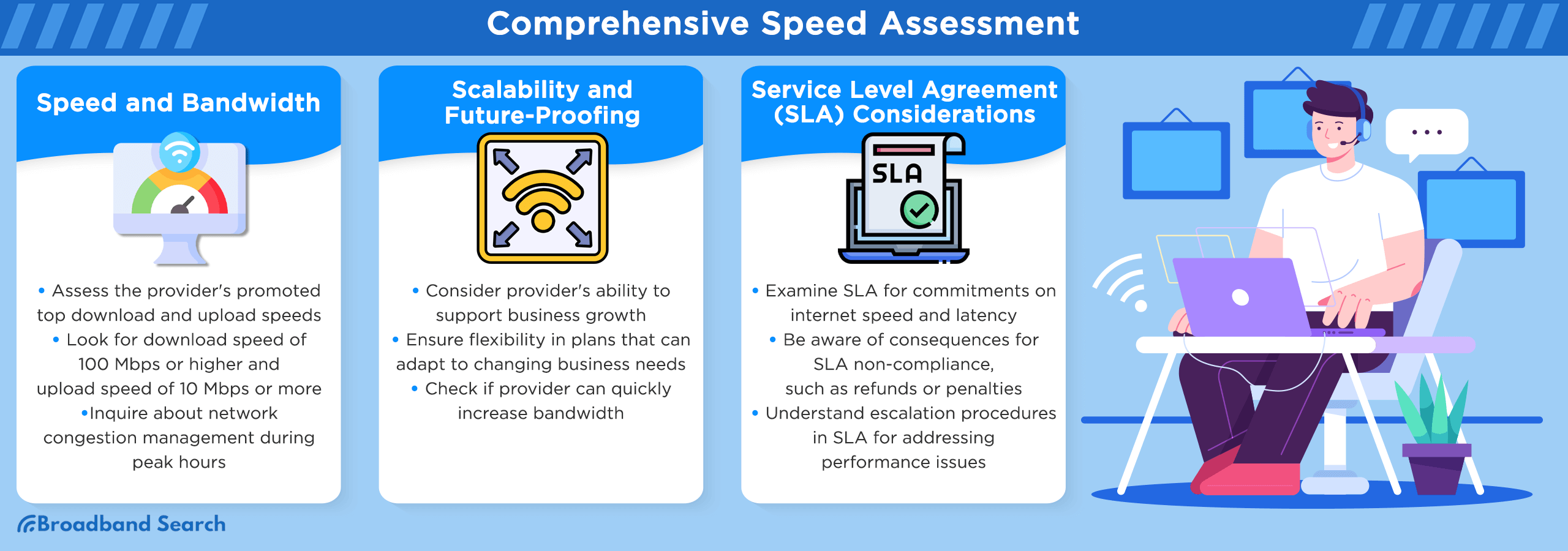
When assessing the speed offerings of a business internet provider, consider several key factors to ensure a comprehensive evaluation.
- Check the provider's promoted top download and upload speeds. Look for a download speed of around 100 Mbps or higher and an upload speed of 10 Mbps or more.
- Ask about how the provider manages network congestion during peak hours, as this can impact your internet performance.
- Understand the difference between burst speeds (quick, momentary surges for fast downloads) and sustained speeds (consistent speeds over time) to anticipate your internet's performance during various tasks.
Scalability and Future-Proofing
When choosing an internet provider, it's crucial to think about how well they can support your business as it grows. Consider how much your business might grow in the future—whether you'll hire more employees or use more data-intensive tools. Your provider should be ready for this. Make sure your provider offers plans that can change with your business; you don't want to be locked into something that won't fit your needs in a year.
Check if your provider can quickly give you more bandwidth if you need it. This is important as your data needs increase. Ask if the provider plans to make their technology better, as newer tech can mean faster and more reliable internet. Finally, look at the fine print in your contract and make sure it's easy to make changes as your business grows. Thinking ahead about these factors helps keep your internet service in sync with your business's growth, so you won't run into any problems down the line
Service Level Agreement (SLA) Considerations
When examining the Service Level Agreement (SLA) provided by your internet provider, consider the following methods for testing internet speed and latency to gauge performance accurately:
Take a close look at the SLA. It's like a promise from your provider about how good your internet should be. Look for what they say about how fast your internet should be and how long it should take for data to travel back and forth. Sometimes, providers promise a certain level of performance. When providers don't meet their SLA commitments, consequences can include refunds or discounts for customers, defined steps for addressing issues, the possibility of ending the contract without penalties, and, in extreme cases, legal action to seek compensation for losses.
Regularly conduct speed tests. These tests act like check-ups for your internet, allowing you to monitor its performance over time and ensure you get what you're paying for.
Sometimes, it's a good idea to get a second opinion. Use tools or services from other companies to check your internet's speed and how quickly data moves. This can give you a fair and unbiased view of how well your internet is working, without relying only on what your provider says.
Familiarize yourself with the escalation procedures outlined in the SLA for addressing performance issues. Understanding the steps to take if your provider fails to meet agreed-upon speed and latency standards is essential for resolving any disputes.
Service Level Agreement (SLA) in Depth: Reliability and Uptime
To ensure you get what you pay for, focus on service level agreements or SLAs. SLAs are like ground rules that say what you should expect from your provider and what happens if things go wrong. In the SLA, watch out for terms like "uptime guarantee" (how often your internet should work), "downtime definition" (what counts as a problem), and "compensation" (what you get if things don't go as promised).
Also, consider redundancy measures, which are like backup plans. Failover systems are like safety nets that kick in if your main connection fails. And having different paths for your data to travel ensures your internet keeps going, even if one route has a problem.
To check how good a provider has been in the past, ask them for historical uptime records. You can also look at online resources that track internet service performance. Contact other businesses in your area that use the same provider. They can give you the scoop on how well the provider handles busy times and local network issues.
Customer Support and Service Level

24/7 Availability and Responsiveness
When checking customer support, focus on two things: availability and responsiveness. You want support that's available 24/7. That means you can get help anytime, even in the middle of the night. However, it's important for businesses not to rely solely on what service providers claim about their response times and availability. While providers may advertise their responsiveness, trusting self-reported metrics can be risky.
To ensure accurate information, businesses can seek third-party sources and independent reviews, such as websites like Trustpilot, Better Business Bureau, or industry-specific forums. Additionally, reviewing the Service Level Agreement (SLA) terms can provide insight into response time guarantees, but cross-referencing these commitments with real-world feedback from other customers is a prudent practice.
Technical Expertise
To make sure you get good support, look at the technical know-how of the provider's support team. Think of it like checking if your car mechanic is well-trained. Ask if their support people have certifications like Cisco CCNA or CompTIA Network+. These show they've had the right training. Also, find out how much experience they have.
Customer Reviews and Reputation
Check out what other businesses are saying. Look for customer reviews on platforms like Google, Yelp, or industry forums. These reviews tell you how other businesses liked the provider's service and give you an idea of their overall reputation. Just keep in mind that not all reviews may be entirely honest, so it's a good idea to consider the source and motivations behind the reviews.
Security and Data Protection
Choosing the right business internet provider is not only about fast and reliable internet; it's also about keeping your important data safe and following the rules in your industry. Focusing on things like security, protecting your data, having backups, and following the rules makes your business strong against online threats. This also helps build trust with the people who rely on your business.
Firewall and Intrusion Prevention
Firewalls act like digital barriers, keeping unauthorized users out of your network. Intrusion prevention systems are like security guards that watch for suspicious activities and block them. Anti-malware systems help detect and remove harmful software that could harm your data.
Data Encryption
Data encryption is like putting your information in a locked safe. It ensures that your data remains confidential and secure during transmission and storage. Encryption protocols use complex algorithms to scramble your data, making it unreadable to anyone without the decryption key. When evaluating providers, inquire about their encryption methods and protocols to ensure your data's safety.
Backup and Disaster Recovery
Imagine having a spare set of keys in case you lose the original. Backup and disaster recovery options work similarly. They create copies of your data and systems, so if something goes wrong, you can quickly restore them. Look for providers that offer regular data backups and a clear plan for disaster recovery.
Pricing and Contract Terms
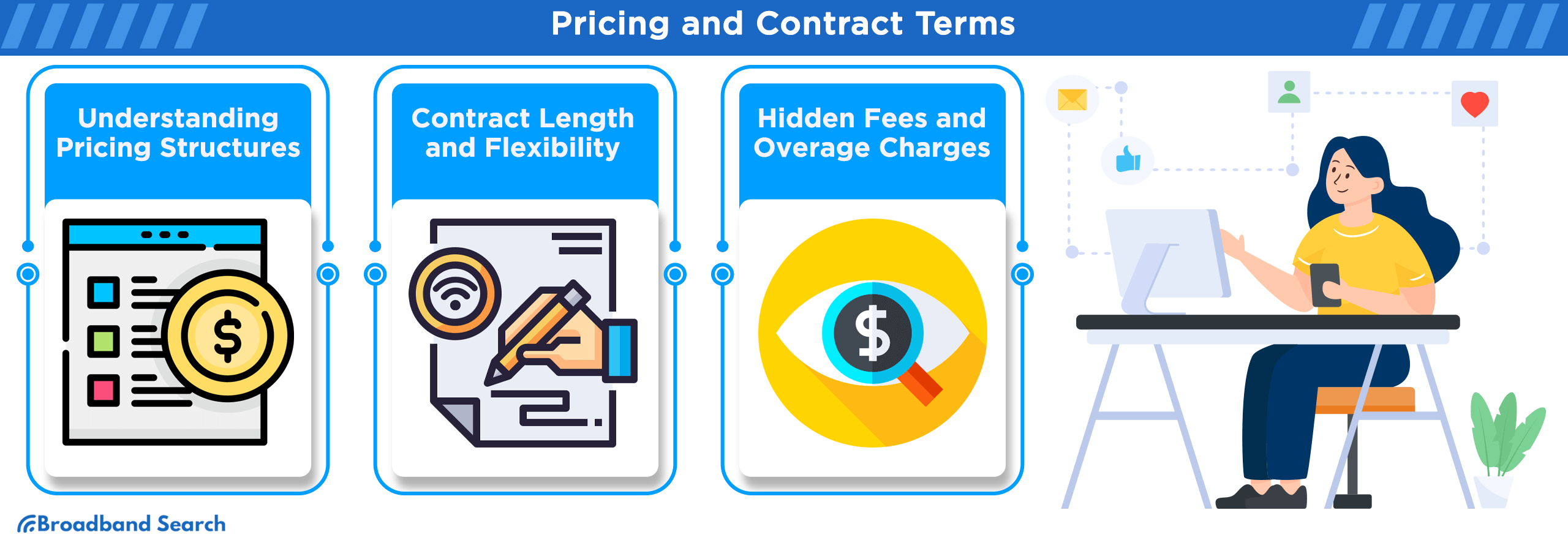
Understanding Pricing Structures
To make an informed decision, it's crucial to understand how the costs are structured:
- Monthly Service Fees: As the name suggests, these are the recurring costs of your internet subscription that you pay monthly. It's the standard fee to keep your internet connection active.
- One-Time Installation Costs: Consider these as the setup fees you initially pay when installing the internet. They cover things like setting up cables and equipment.
- Equipment Expenses: Occasionally, you'll need special equipment like a modem or router. These might have their own fees, similar to buying or renting tools for a specific job.
Contract Length and Flexibility
Consider how long you're willing to commit to a contract. Longer contracts might offer lower monthly fees but can be less flexible.
Think about how flexible you need your contract to be. Shorter contracts give you more freedom to switch providers or change plans. Longer contracts might lock you in but could offer cost savings. Weigh the pros and cons based on your business's needs.
Don't be afraid to negotiate contract terms. Providers may be open to adjusting contract lengths or offering discounts to win your business. Be clear about your needs and explore options to find the best deal for your company.
Hidden Fees and Overage Charges
Like your phone bill (among many others), internet bills can have hidden fees. These are extra costs that aren't always obvious. One example of this is the administrative fee, which is usually around $1.99 per month. Ask your provider to explain all potential fees, such as early termination fees or administrative charges. Transparency is key.
Be cautious about exceeding data limits. Some plans come with data caps, and going over them can result in overage charges or connection throttling. Understand your data usage and choose a plan that suits your needs to avoid unexpected costs.
Additional Services and Features
When selecting a business internet provider, it's essential to consider additional services and features that can enhance your operations.
Static IP Addresses
Think of a static IP address like having a fixed home address versus a changing hotel room. Static IP addresses are essential for businesses that need consistent and easily recognizable internet addresses. They're ideal for:
- Hosting your own website or email server.
- Remote access to your company's network.
- Running online services like video conferencing or security cameras.
- Enhanced cybersecurity through more precise control and monitoring of your online assets.
Web Hosting and Email Services
Web hosting is like renting space on the internet to store your website. It's crucial for businesses that want to have an online presence. Consider factors like customization options, reliability, and customer support when choosing web hosting services.
For email, look for providers that offer customizable email domains (e.g., yourname@yourcompany.com) and ensure that email servers have strong security measures to protect sensitive information.
Cloud Services Integration
Integrating cloud services with your internet provider can boost efficiency and accessibility. Cloud services allow you to store data, run applications, and collaborate online. Ensure that your internet provider supports seamless integration with popular cloud platforms like AWS, Microsoft Azure, or Google Cloud.
VoIP and Phone Services
Voice over Internet Protocol (VoIP) is a technology that allows phone calls over the Internet. It offers several advantages for businesses:
- Quality: VoIP can provide high-quality voice calls, and with a reliable internet connection, call clarity rivals traditional phone lines.
- Cost-effectiveness: VoIP tends to be more cost-effective than traditional phone services, especially for international calls.
- Scalability: VoIP systems are scalable, making them suitable for businesses of all sizes. You can add or remove lines as your needs change.
While VoIP offers several advantages, it's essential to consider potential downsides:
- VoIP calls can sometimes suffer from problems like delays, background noise, or echo, affecting the overall call experience.
- VoIP heavily relies on your internet connection. If your internet goes down, your phone service will also be disrupted.
Comparing Providers
When comparing business internet providers, a structured approach can help you make an informed decision. Here's how to research and shortlist local and national providers:
Researching Local and National Providers
Begin by conducting online research. Use search engines to find local and national business internet providers. For instance, a search for "business internet providers in [your city or region]" can yield results. Explore the websites of providers like AT&T, Comcast Business, Spectrum Business, and local providers specific to your area.
Also ask business colleagues for recommendations. If you're based in a specific city, you might ask fellow business owners in local business associations about their experiences with providers in your area.
Check industry-specific directories like the New York City Technology Forum or local business directories that list internet service providers operating in the city. These directories often provide contact information and brief overviews of each provider's services.
Requesting Quotes and Proposals
Once you've identified potential providers, you can reach out to them for quotes and proposals. Contact providers through their websites request forms, or by reaching out to their sales teams directly. You can get in touch with Spectrum Business or Earthlink Business Internet, among others. Provide them with details about your business needs, such as the required internet speed and the number of employees. This will help you gather essential information to make an informed decision about your internet provider.
In your requests, include specific information about your location, preferred internet plan, and any additional services you need. You might request a quote for a 100 Mbps fiber-optic internet connection with phone service for your office in Manhattan.
During your discussions with providers, don't hesitate to ask questions about contract terms, installation timelines, and any promotional offers they may have. You can inquire about options like fixed IP addresses or dedicated customer support.
Side-by-Side Provider Comparison
Critical Evaluation Criteria: Develop a list of criteria that are essential for your business. This might include factors like pricing, speed, reliability (e.g., uptime guarantees), contract terms (e.g., length and flexibility), customer support (e.g., 24/7 availability), and additional services (e.g., VoIP or cloud integration).
Compare Offers: Once you've received quotes and proposals from different providers, create a spreadsheet or table to compare them. An example of this can be seen in the table below:

Consider Long-Term Implications: Beyond immediate cost savings, consider the long-term implications of your choice. For instance, evaluate the scalability of the plan if your business is expected to grow.
Final Thoughts
Choosing the right internet provider for your business is a crucial decision that can significantly impact your operations. First, understand your business needs, including factors like speed, reliability, and additional services required. Be mindful of your budget for service, not only the monthly fees but also hidden costs and contract terms, to maintain financial stability. Explore the availability of extra services like static IPs, web hosting, and VoIP, as these can enhance your business toolkit.
Just as you would adjust your strategies to stay competitive, be ready to adapt your internet solution to keep your business running smoothly. By considering these factors and staying flexible, you'll be well-prepared to achieve success and thrive in the digital age.
FAQ
What factors should I consider when selecting a business internet provider?
Consider factors like speed, reliability, security, contract terms, additional services, and budget to choose the provider that best fits your business needs.
How do I determine the appropriate internet speed for my business?
Determine the appropriate internet speed for your business by considering the number of users, the devices, and the types of online activities you engage in. Aim for a balance between download and upload speeds that meet your demands.
What's the significance of a Service Level Agreement (SLA) in my internet contract?
An SLA outlines the provider's commitments regarding uptime, speed, and support. It's essential to ensure you receive the service quality you expect and address potential issues.
Why is it important to consider scalability when choosing an internet provider?
Scalability ensures your internet solution can grow with your business. It's crucial to avoid limitations as your company expands and its internet needs increase.
How do I compare different business internet providers effectively?
To compare business internet providers effectively, research local and national options, request quotes, and create a side-by-side comparison of key factors like pricing, speed, contract terms, and additional services.

